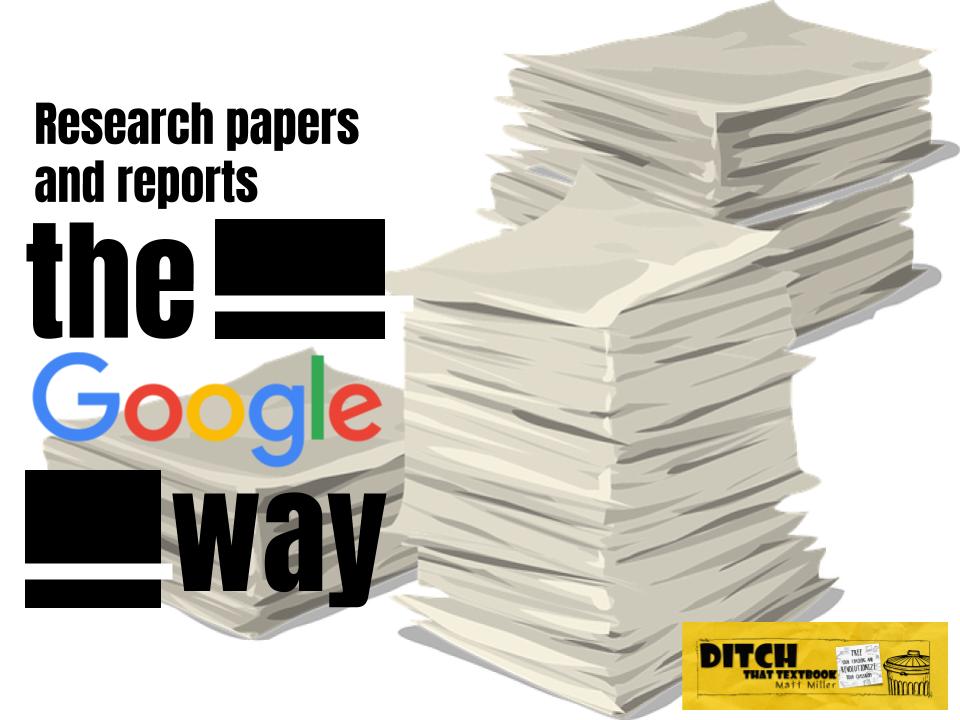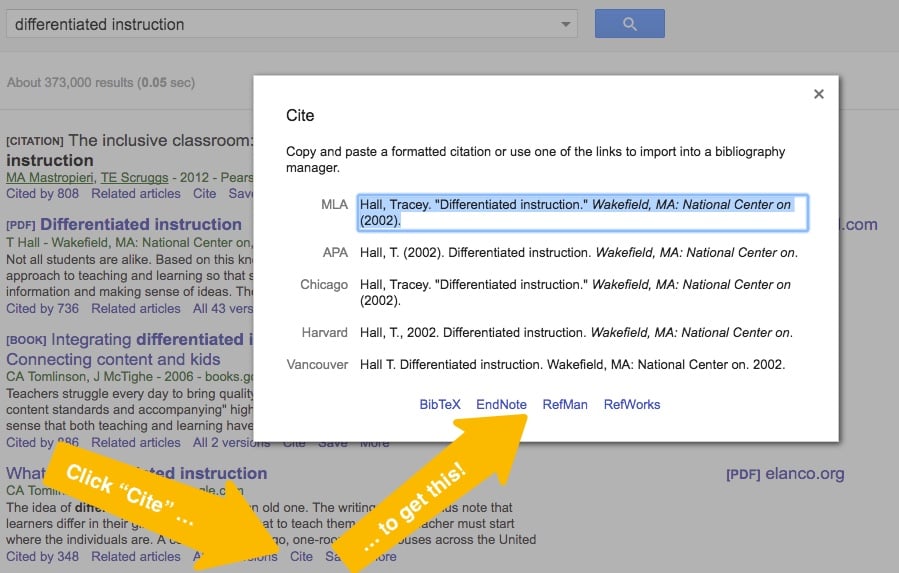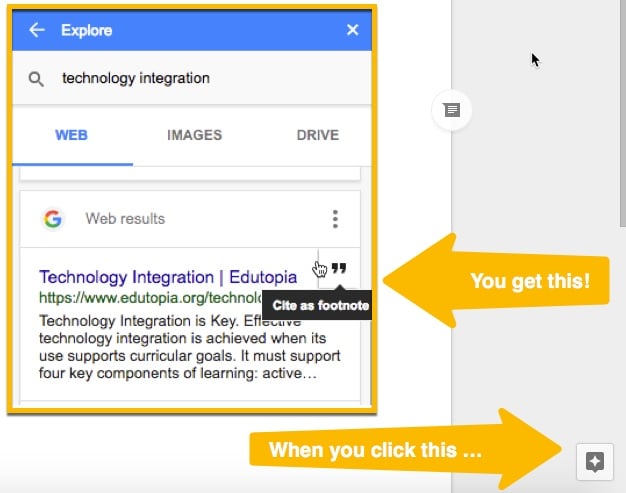

Research reports and papers can be streamlines and improved with a few handy Google tools. Here’s a workflow your students can use. (Public domain image via Pixabay.com)
The traditional research paper has been around a long time. We all likely have a memory of sweating over one at the last minute.
They’re still a staple in K-12 schools and in universities.
We don’t use formal academic papers and reports that much in real life. Often, they’re sources for more academic papers and reports.
I’m a huge advocate of reinventing the research paper/report. I’d like to think of infographics as “Research Report 2.0”, and there are plenty of other creative options for them. I wrote a blog post about 10 creative alternatives to research reports and papers that may give you some ideas.
If you still need students to do research papers and think it’s a vital skill, Google has you covered. When used in unison, several of its tools let you do that academic work more effectively and efficiently.
Here’s the Google way to do research reports and papers in 10 steps. And please feel free to add your own nuances, changes or additional steps in the comments below!
1. Get started quickly. Instead of having students go to Google Drive to start a new document, try one of these two ideas:
2. Take organized notes in Google Keep. Google Keep is like index cards or sticky notes. They can be color coded or organized by label (kind of like the tabs on filing folders). It’s an amazing way to help students gather information and keep it in one place.
Some suggestions for student note-taking in Google Keep:
3. Add notes with other tools. Students don’t just have to go to the Google Keep site on a computer or Chromebook to use Keep. Here are some other options:
4. Use split screen. Sometimes, it helps to have research open on one half of the screen and a place to take notes (like Google Keep!) open on the other half. Tab Scissors and Tab Glue are great Chrome extensions to make that happen.
5. Don’t copy words. Gather ideas. It will be tempting for students to highlight, copy and paste text from their sources into Google Keep. I would encourage them to avoid that at all costs. If they copy/paste text into their Keep notes, they’ll have to make sure it’s in their own words when it’s written into the assignment. (And it’s probably much easier to write it in their own words while creating notes in Keep.)
6. Use Google Scholar to find more scholarly works. If students need to include published research, journal articles or other more academic sources, Google Scholar (scholar.google.com) is a great resource. Not everything is available for free with full text, but there’s LOTS of great stuff there.
7. Organize material in a document. Here’s where the magic starts. Since Google added Keep to its core G Suite tools, Keep and Docs work together on one screen.
To open the Keep notepad in Google Docs, go to Tools > Keep notepad.
When you do, your Keep notes are displayed in a sidebar. From there, you can add a new note, search your notes and scroll through your notes. But that’s not the best part.
You can drag notes directly from the Keep notes sidebar into a Google document.
Brilliant!
One way to execute this:
8. Add images responsibly. Google Docs has an image search built in that pulls Creative Commons and public domain images from databases on the web. These images are licensed for use by students. When they find an image and click on it, they can see the source of the image (see below). This is a great place to track down the image, make sure it’s licensed as Google suggests, and gather the attribution information to include with the image. (See more: How to get and use free images — the RIGHT way — in class)
9. Create charts in Google Drawings, Sheets or Forms. Visuals solidify new ideas in our minds. Plus, by creating visuals, students get a firmer grasp on the content they’re learning. Here are two ways students can create their own visuals:
10. Cite your sources easily. I have clear memories of thumbing through a style manual in college to appropriately cite sources in my papers. Those days are gone (or can be gone if we let them). Several tools can help students:


Voila! Your report or paper is now complete.
Of course, don’t forget that it’s easier than ever to share student work widely with a big audience. Consider letting students publish their work on a website, share it via social media or more.
[reminder]What other steps or tools would you add to this list? How have Google tools — or technology in general — helped your students to write differently or more efficiently?[/reminder]For notifications of new Ditch That Textbook content and helpful links:
Interested in having Matt present at your event or school? Contact him by e-mail!
Matt is scheduled to present at the following upcoming events:
[getnoticed-event-table scope=”upcoming” max=”15″ expanding=”false”]
Session expired
Please log in again. The login page will open in a new tab. After logging in you can close it and return to this page.
[…] Some handy Google tools can streamline research and writing for your studnets. Click here for ideas! […]
I also asked Ss to share video links as evidence, documentaries, tweets, Google analytics,and podcasts. Very fun. Thank you for this post which ignited discussion within our curriculum
Very inspiring and innovative
[…] Writing papers and research reports the Google way | Ditch That Textbook […]
The last two years my 7th grade Digital Literacy students have used their research to create Infographics instead of research papers. They use their infographics as a visual aide for their district speaking assessment. I have found students truly enjoy and must process their learning.
My students have used the free online versions, piktochart.com and easel.ly.com. This year my school purchased a pro classroom account for me from easel.ly.com. I love the templates and the ease of use for students.
I love the creativity and knowledge students learn by researching and creating infographics.
Some really great ideas in this post and I love the connection between Keep and Docs. For me, these strategies would be an excellent way of getting younger students to start practicing formal research skills. However, for rigorous research in high school, I’m not sure google tools will hold up against things like the outline builder in Noodle Tools and JSTOR, and having worked closely with teacher librarians, I can now see how students don’t actually learn anything about how to cite correctly through EasyBib – it is a shortcut that often pulls in inaccurate data (although this is improving as machine learning develops). Thanks for these great tips – our K-5 integration specialists will be inspired!
I would be interested to see how a Google Paper would hold up in Turn it In.
Also, since the universities are requiring research papers – many 10 per semester, should we not teach the kids to write on at the high school level? I’m all about using variety of practices, but ditching the research paper – now way. (And kids ARE just copying and pasting and NOT gathering ideas because they are lazy and have had too many teachers not care enough to catch them.)
Wow, Heidi. Looks like something touched a nerve here. OK, a couple of thoughts …
— A “Google paper” isn’t really a thing. What I’m suggesting here is using Google tools to streamline the writing process.
— How students write their papers determines how they “hold up in Turn It In.” Again, gather ideas instead of copy facts.
— Universities aren’t the end all be all of education. Just because higher education engages in certain practices (some of questionable pedagogical value) doesn’t mean that we have to adopt poor instructional strategies for the sake of getting kids “ready for college.” If we help students become savvy information gatherers, critical thinkers and problem solvers, I’m convinced that they’ll be able to work their way through lectures, long textbook readings and 10 research papers.
— Let’s not paint ALL students with such broad strokes. SOME students copy and paste and don’t gather ideas. (And SOME students do that because they don’t see the value in certain assignments nor the connection to their lives or “real life.” Another reason to ditch some — if not all — research papers …)
You lost me a bit at the Google Citations part, but I thought this was a great post! I don’t really do a traditional research paper but if I did I feel like I’d totally want to use the tools you’ve mentioned. Very inspiring.
“Google Citations” isn’t really a thing. You can do works cited/bibliography by pulling it from the Explore tool and from Google Scholar. Thanks Anna … glad you liked it!